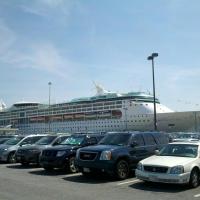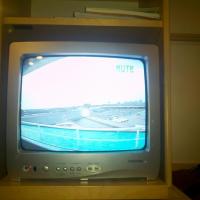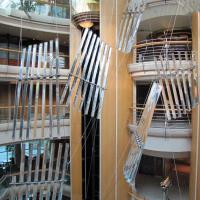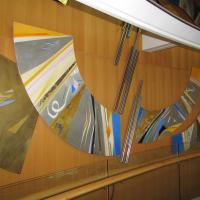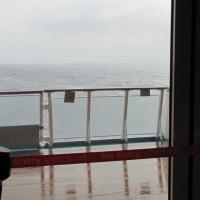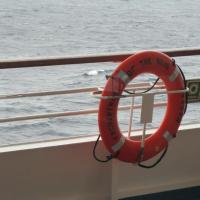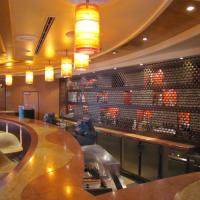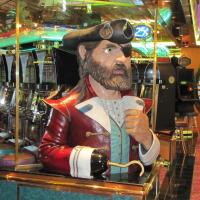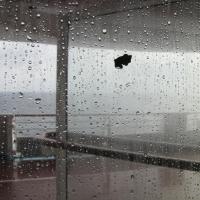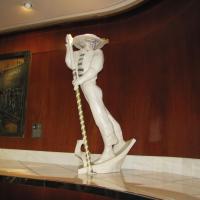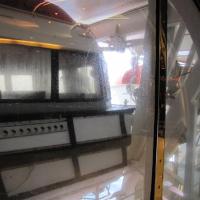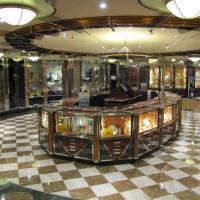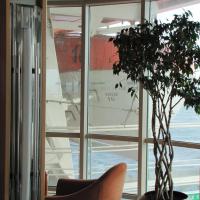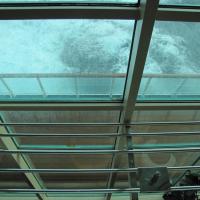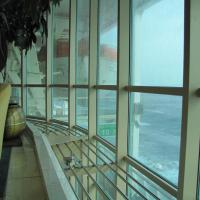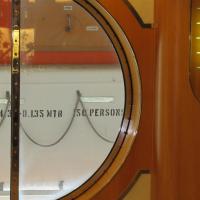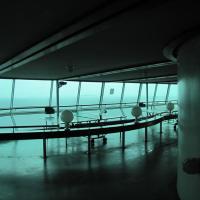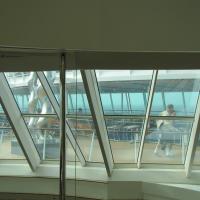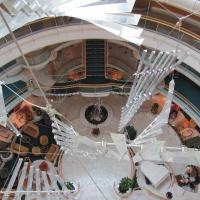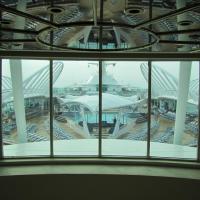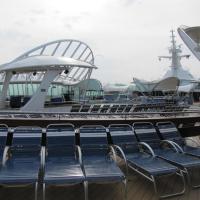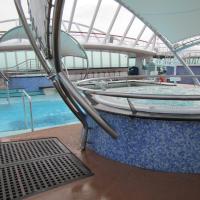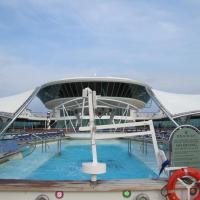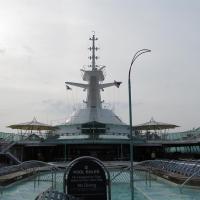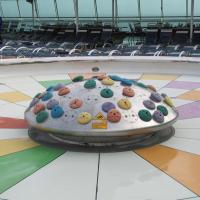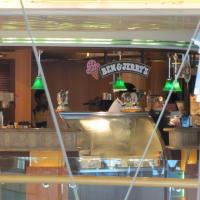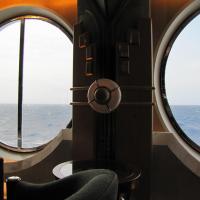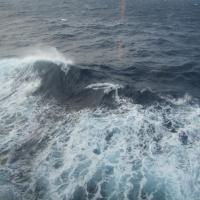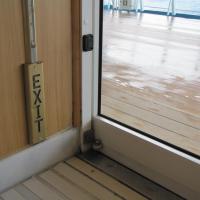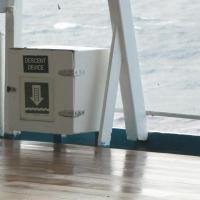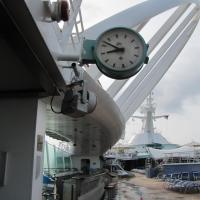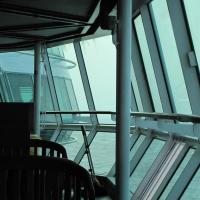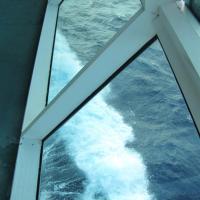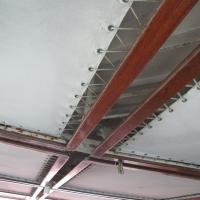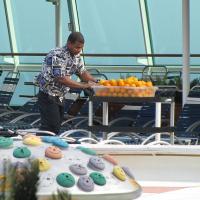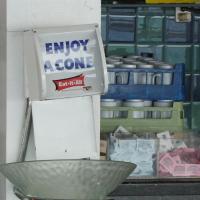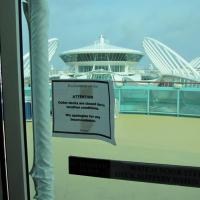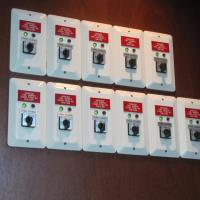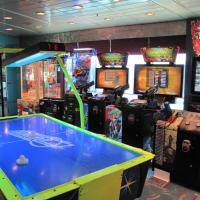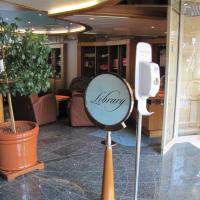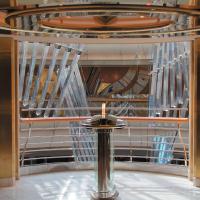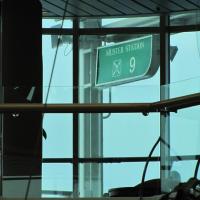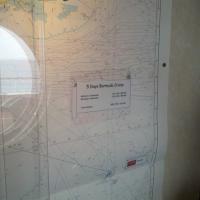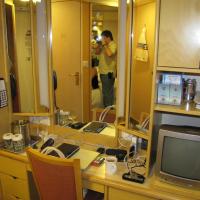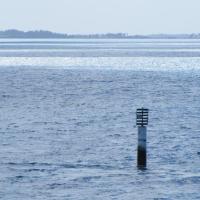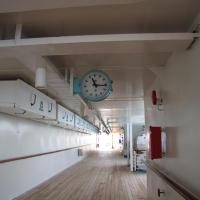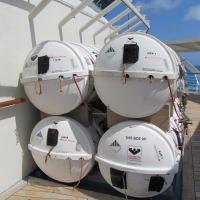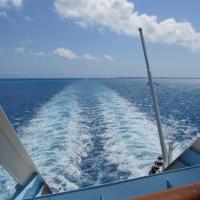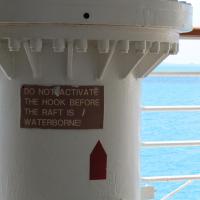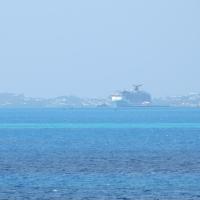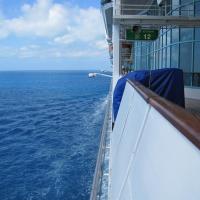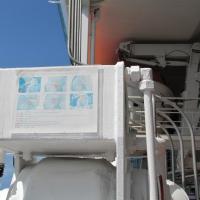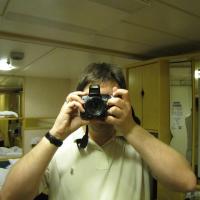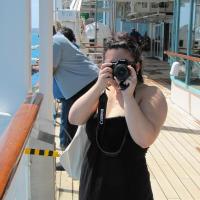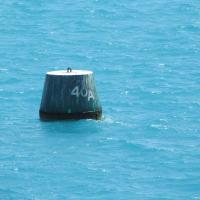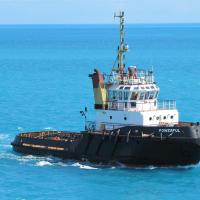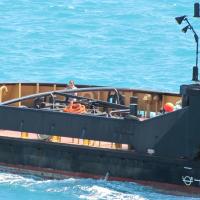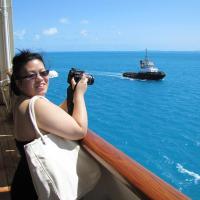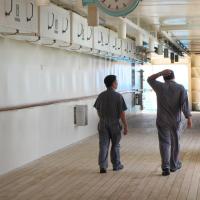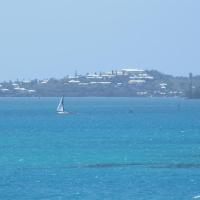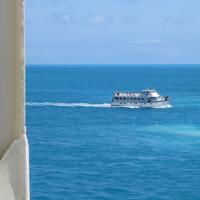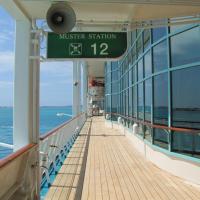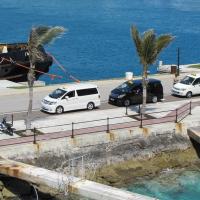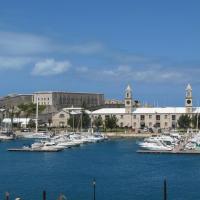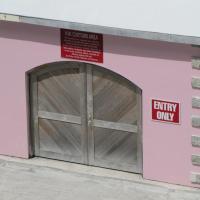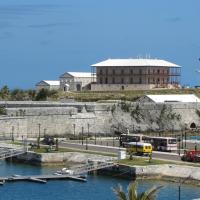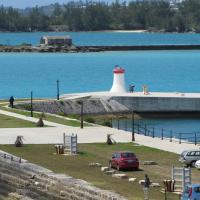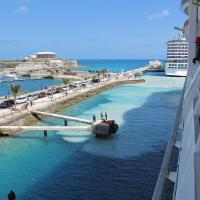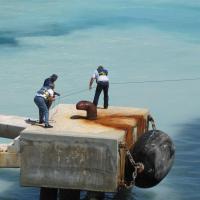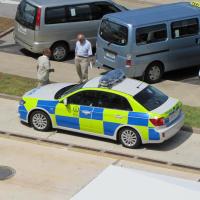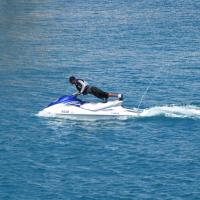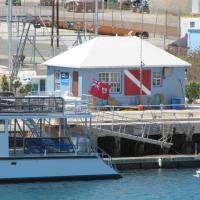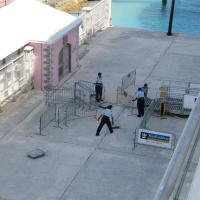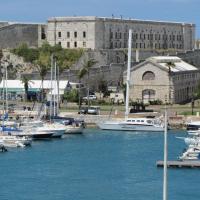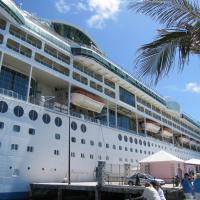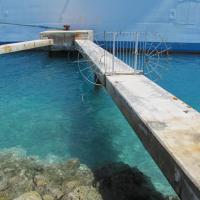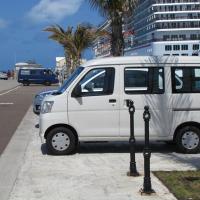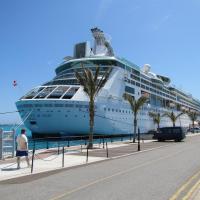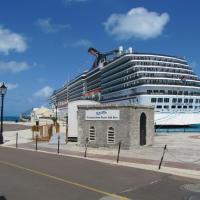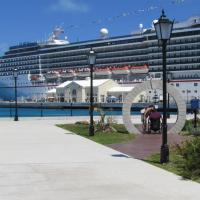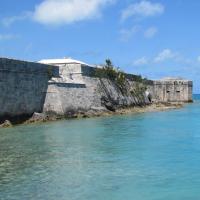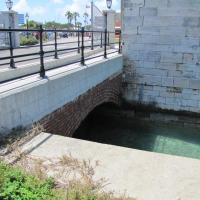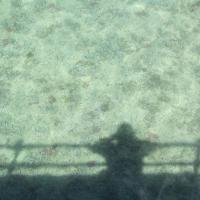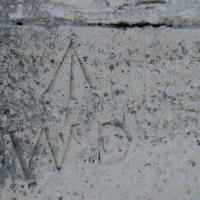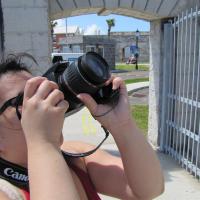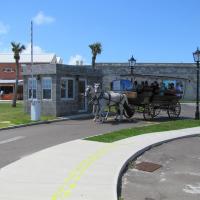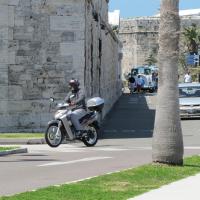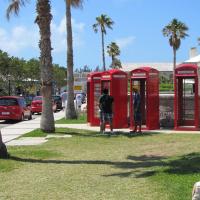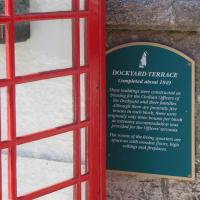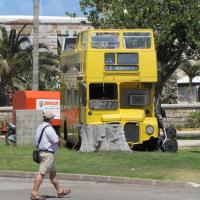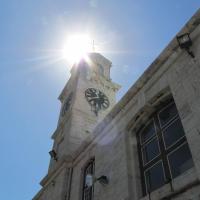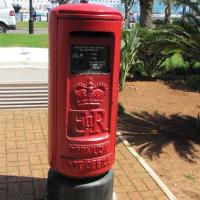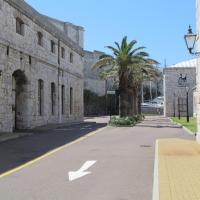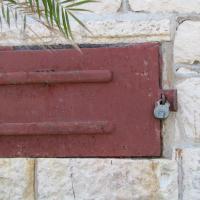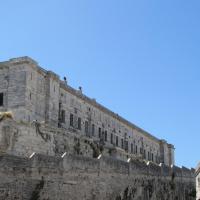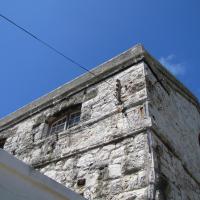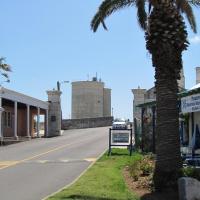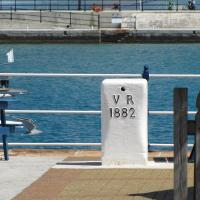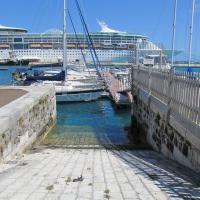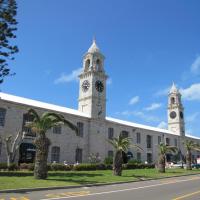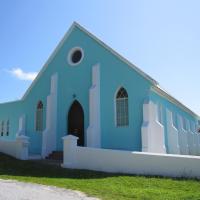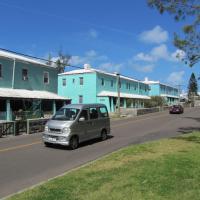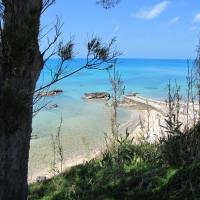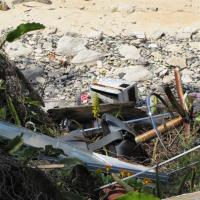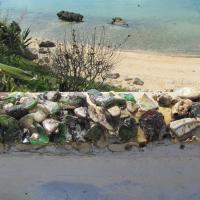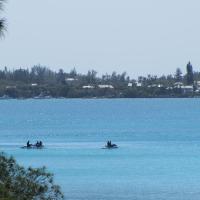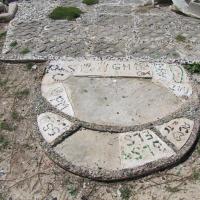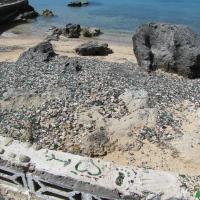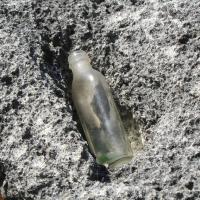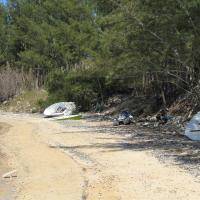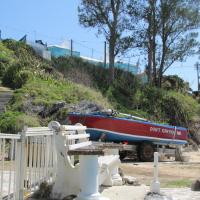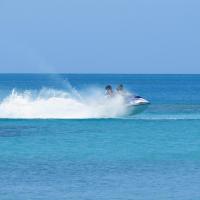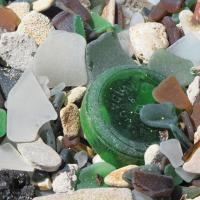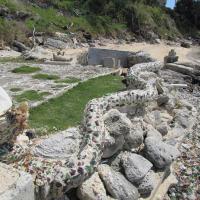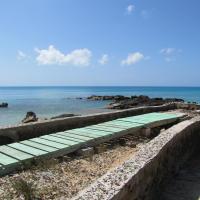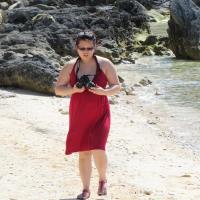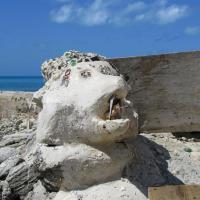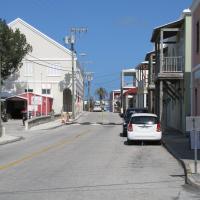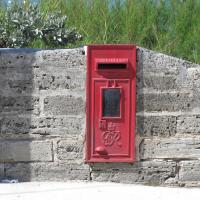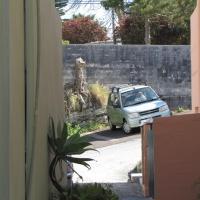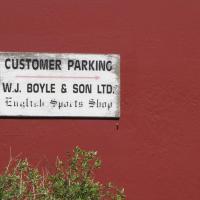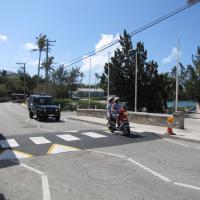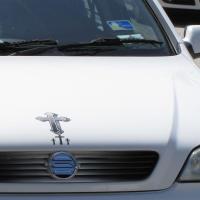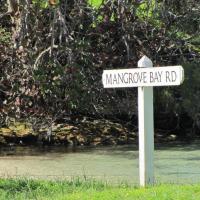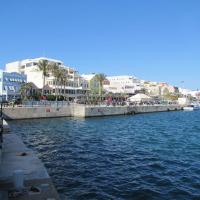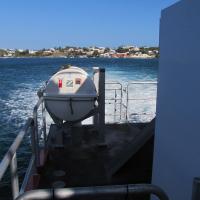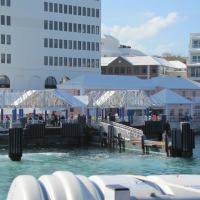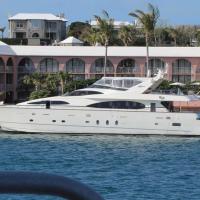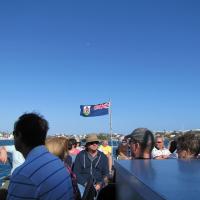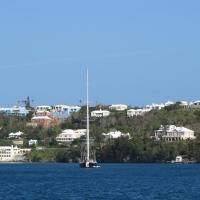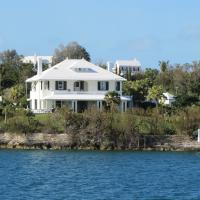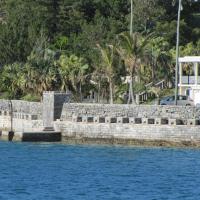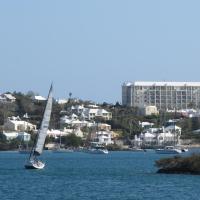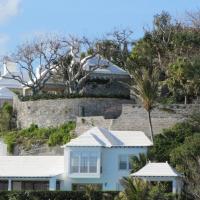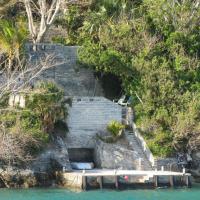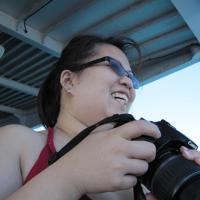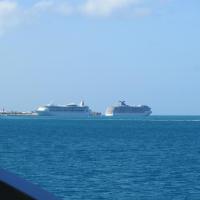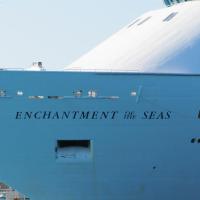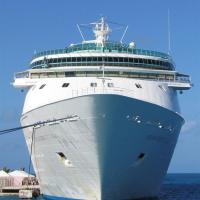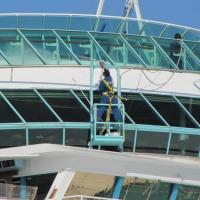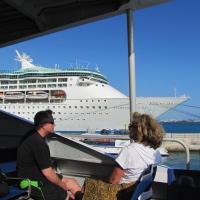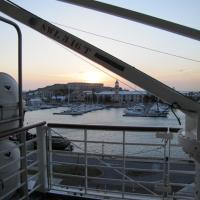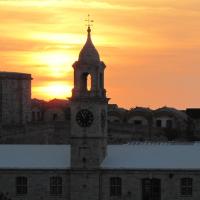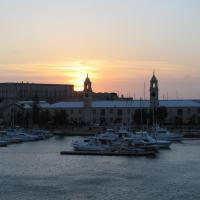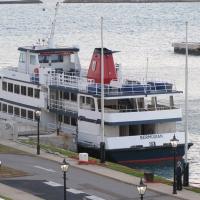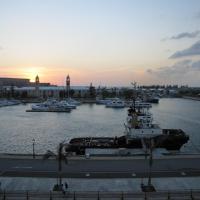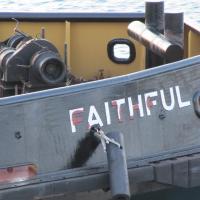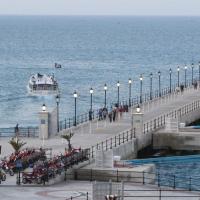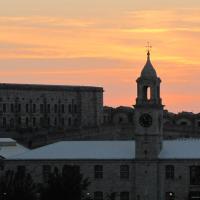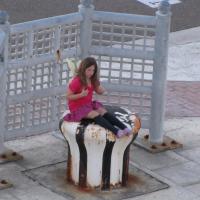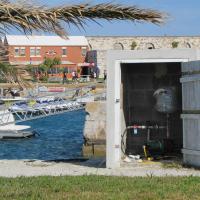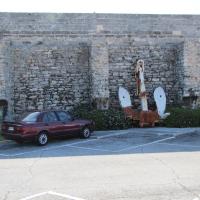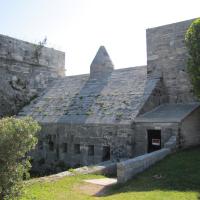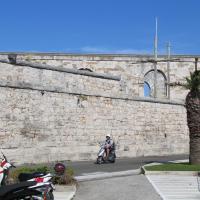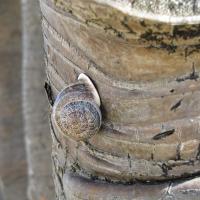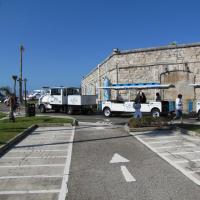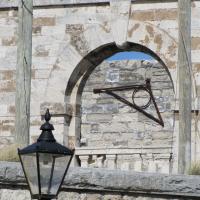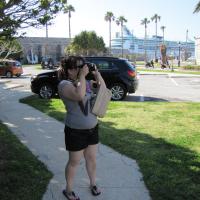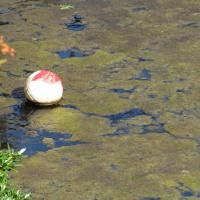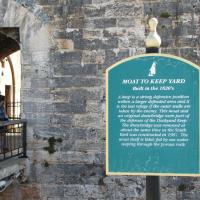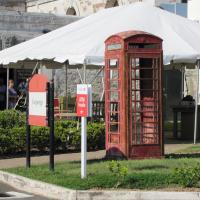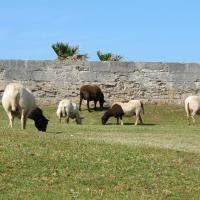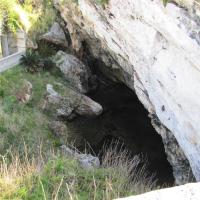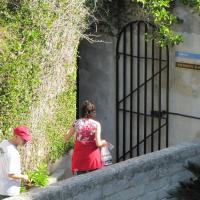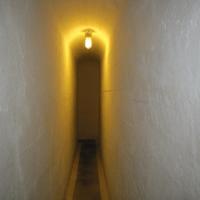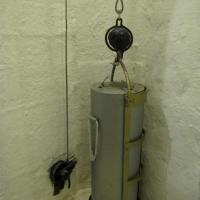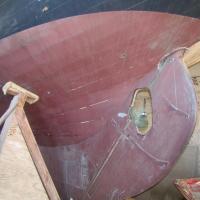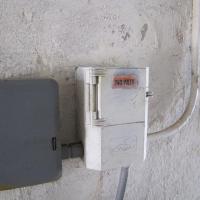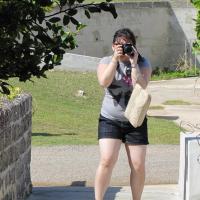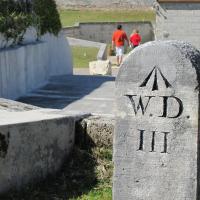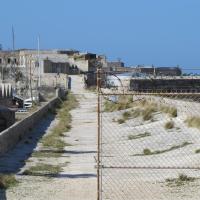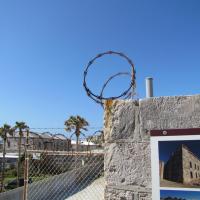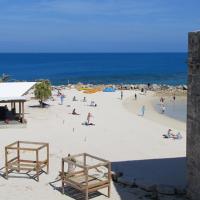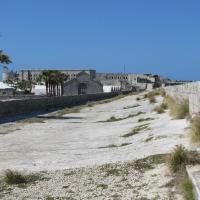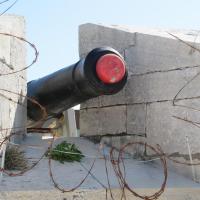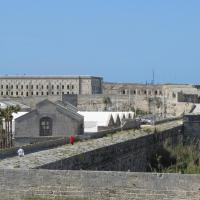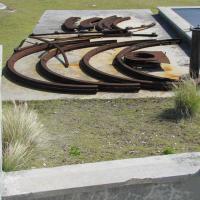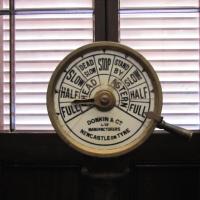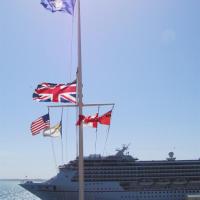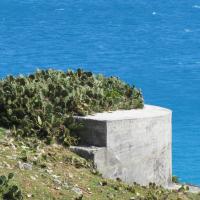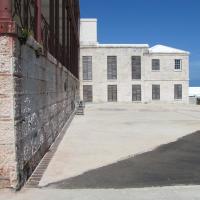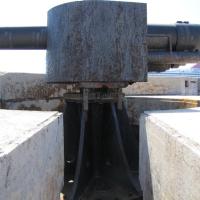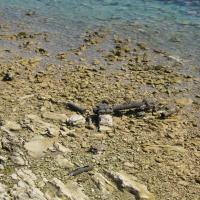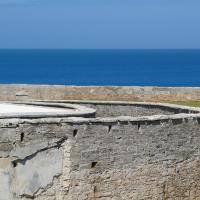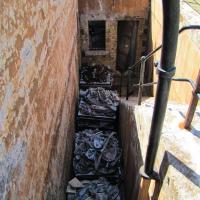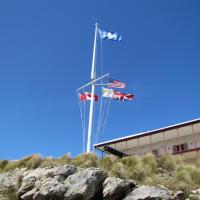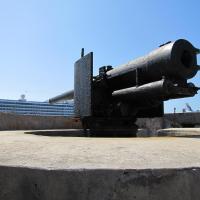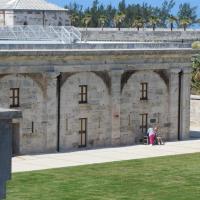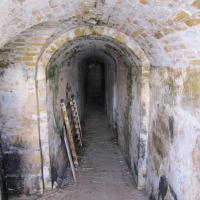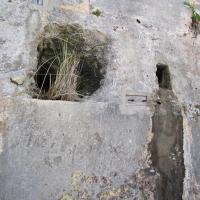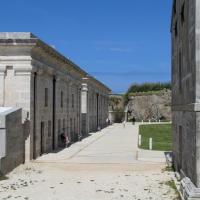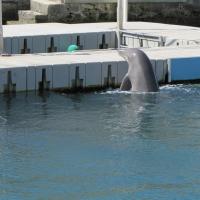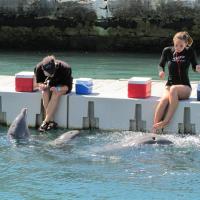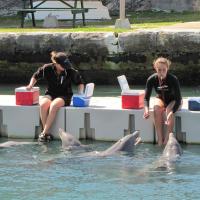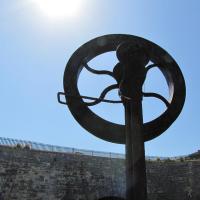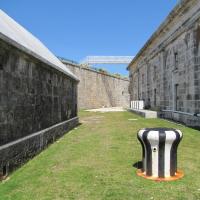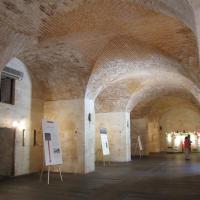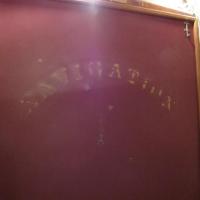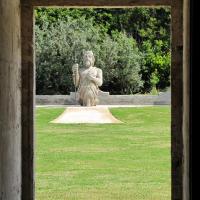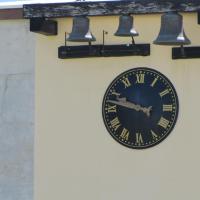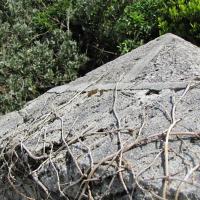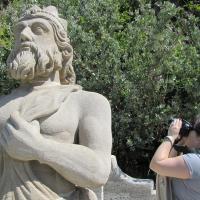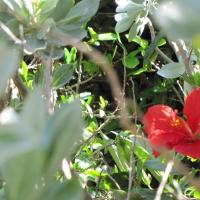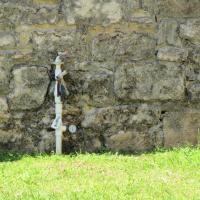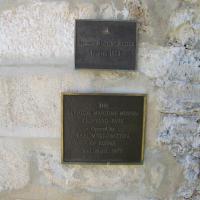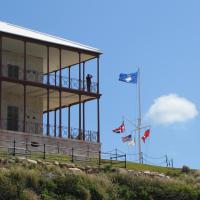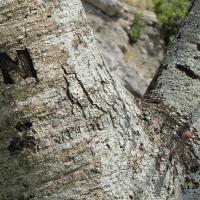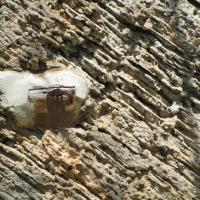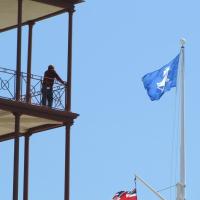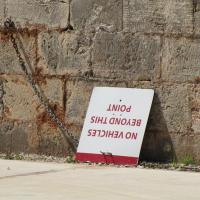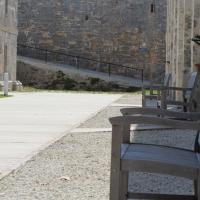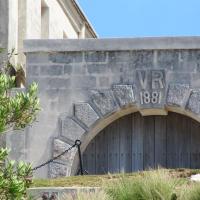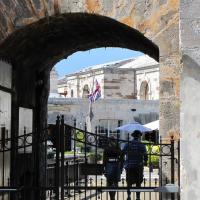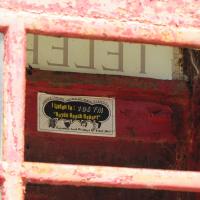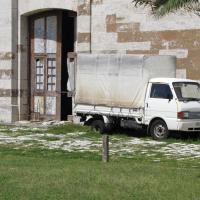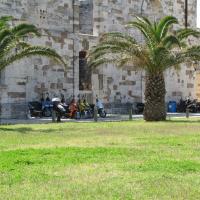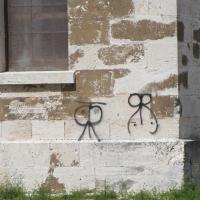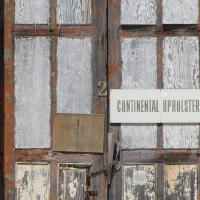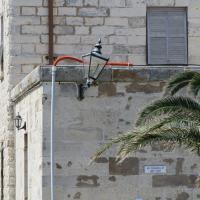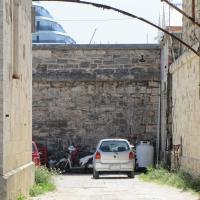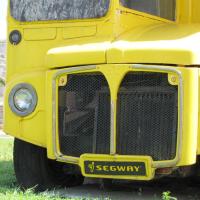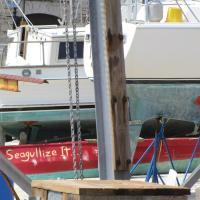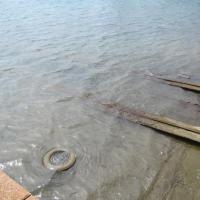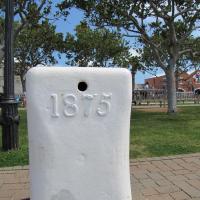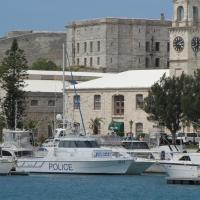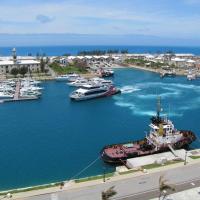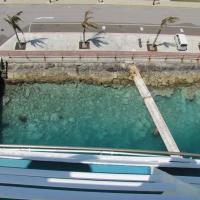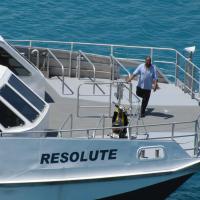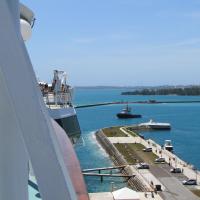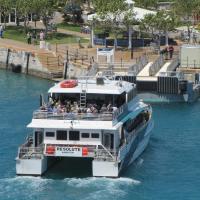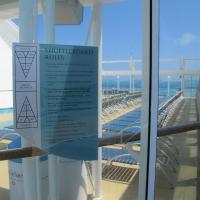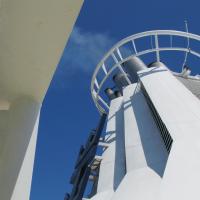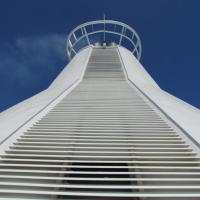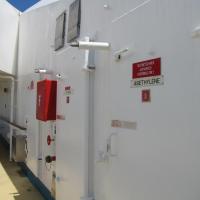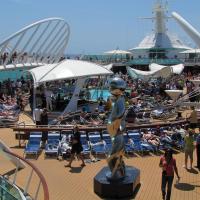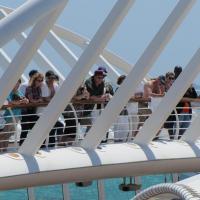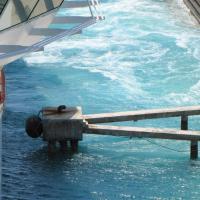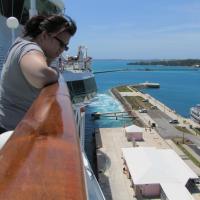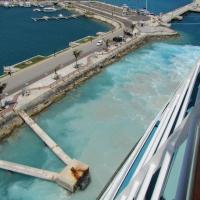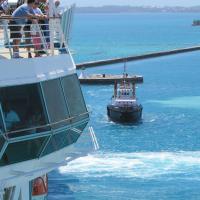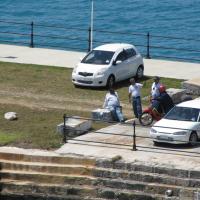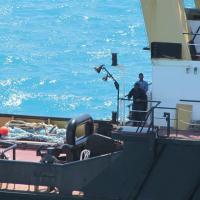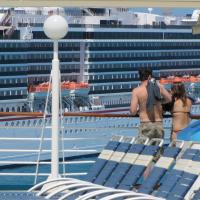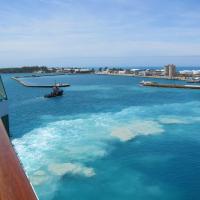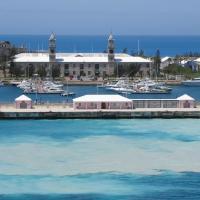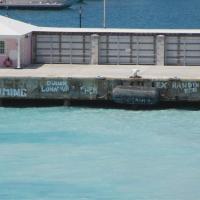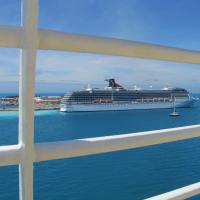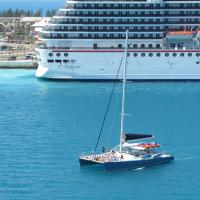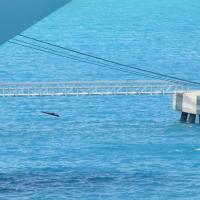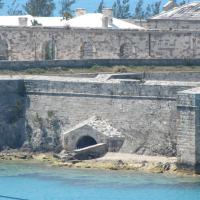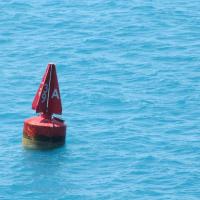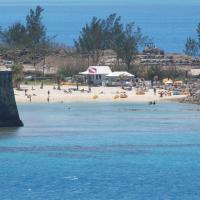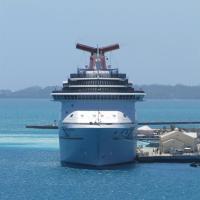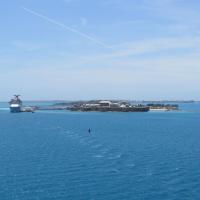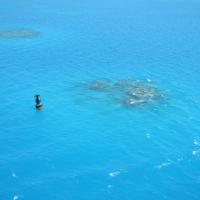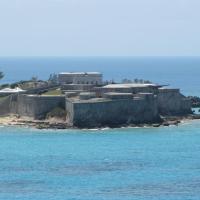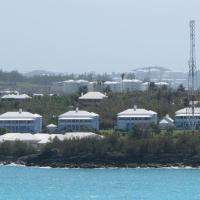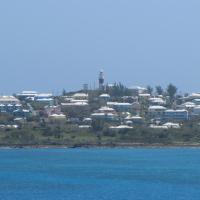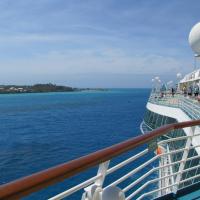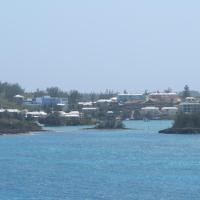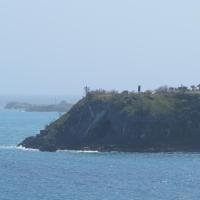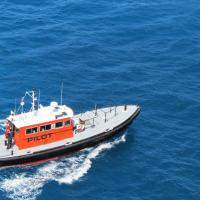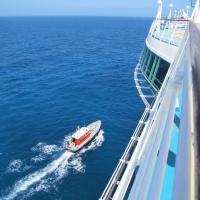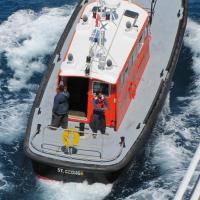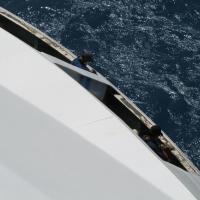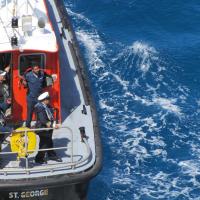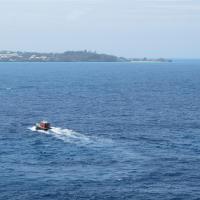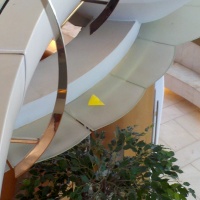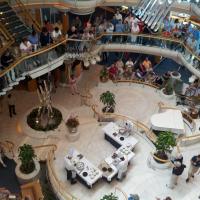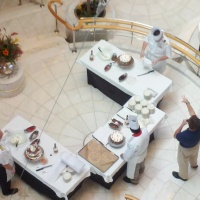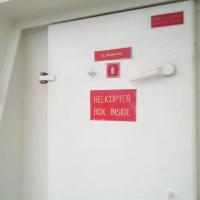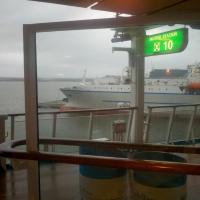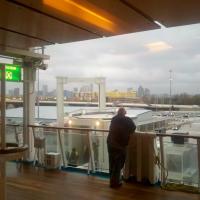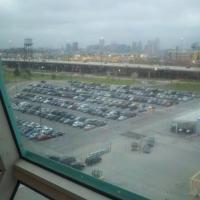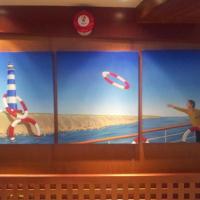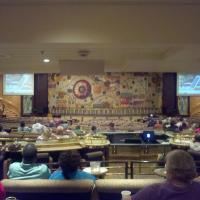Melissa and I spent this last week on a Royal Caribbean five-day cruise. It left from Baltimore, Maryland, on Monday afternoon and arrived in Kings Wharf, Bermuda mid-day Wednesday. We then left Bermuda mid-day Thursday and returned to Baltimore on Saturday morning.
This is the fourth time we have been on a cruise, but our first time cruising out of Baltimore, our first time on Royal Caribbean, and our first time to Bermuda. Previously we have cruised twice to Alaska on Holland America (out of Seward, Alaska, and Victoria, BC), and once to the Caribbean on Carnival (out of Ft. Lauderdale, FL).
All-in-all we had a great trip, despite a rocky start in Baltimore, and it was good to get away for a week and relax. Bermuda is a lovely place, at least what we saw of it, and—as always on cruises—we had a lot of fun and a lot of good food. Read on for details and a ton of photographs!
The Baltimore Cruise Terminal
Melissa and I left home around noon on Monday, swung by the store to pick up a few last-minute items, and drove the hour up to Baltimore. We arrived around 1:30 p.m., well before the 90-minute requirement (the ship was scheduled to leave at 4pm). Unfortunately, however, the authorities that run the Baltimore cruise terminal—still a relatively young terminal—didn’t seem to have any idea what they were doing.
First, there were no signs indicating how to get to the terminal from the Interstate. That wasn’t a big deal since my Garmin GPS knew where to lead me, but I found it very strange that the state of Maryland, city of Baltimore, and the port itself—all apparently so proud that cruise lines sail out of Baltimore now—didn’t think it was worthwhile to throw a sign up on I-95 saying, “Cruise terminal, next right.”
When we pulled in, a guy at a guard booth told us to go to a tent to drop off our bags. When we got to the tent, however, they told us that the tent was for getting luggage tags on our bags . . . luggage tags which had already been mailed to us. They told us to continue onward. At the second checkpoint, another guard told us to proceed straight ahead to check our luggage. We did as we were told, but all the signs said we were supposed to go right. Luckily, the guard was correct. Maybe they should fix the signs.
We dropped off our checked luggage and then had to proceed to the parking lot through an un-signed maze of roads, cones, and barriers. We finally arrived at the entrance to the lot where a woman swiped our credit card. There was only one ship departing at the time, so they knew exactly how much to charge us—$75. We parked and headed into the terminal with our carry-on luggage around 1:45pm.
It was a typical TSA screening, minus the nudity and feel-ups that have begun inexplicably (and unconstitutionally) blighting airport security lines. We didn’t have to take off our shoes, but we did have to separate our laptops from our bags; I still don’t understand the utility of doing that. I doubt there is any. Regardless, we got through without a hitch . . . and immediately landed in an epic line.
The Enchantment of the Seas carried about 2,300 passengers on this cruise, and probably half to two-thirds of them were standing in line in the Baltimore terminal. It was about 85 degrees Fahrenheit outside, and likely higher inside—and without the breeze. The building is supposedly equipped with air-conditioning but, according to one staff member we talked to, it had been turned off because it had been chilly a few days before and they ‘couldn’t’ switch it back to air-conditioning after having just switched it to heat. It sounded like a lie; even if it was true, that doesn’t make it acceptable.
Worse, the company providing check-in services at the port (which was not Royal Caribbean, but some travel services firm) had grossly understaffed the facility. If that wasn’t enough, the high heat in the room was causing the check-in computers to overheat and shut down, exacerbating the delays. If the room had been comfortable, the long wait would have been tolerable. If the room was going to be super-heated and breezeless, they needed to process travelers at a reasonable speed—with enough staff to do the job, and equipment capable of handling the conditions in the building.
By the time we finally got to the check-in table—more than an hour and 45 minutes after walking into the terminal—I had probably lost fifteen pounds in sweat and had a sore shoulder from our carry-on bags (which I did not expect to have to carry more than twenty minutes). The whole point of cruising out of Baltimore is speed, ease, and convenience; they failed miserably on all counts.
None of this was Royal Caribbean’s fault, as best as I can tell. Blame falls squarely on the officials operating the Baltimore cruise terminal. It felt incredibly amateurish and unprofessional compared to the other terminals we’ve been to, and a lot of people were (justifiably) upset about the situation. Baltimore terminal officials are lucky that no travelers, especially the elderly, suffered any medical emergencies due to the poor conditions.
Needless to say, we are much more likely to drive the extra two hours (in our comfortably air-conditioned car) to Norfolk next time we decide to cruise from an east-coast port.
The Enchantment of the Seas
After fifteen or twenty minutes of staged photos and climbing a tall windowed gangway (which was incredibly hot; it was greenhouse-like in the sun), we were finally on board the Enchantment of the Seas. We proceeded directly to our cabin and arrived around 3:50 p.m., only ten minutes before scheduled departure.
We only had a couple minutes to put down our carry-on bags, poke around a little, and wash the layer of sweat from our faces before it was time for the lifeboat drill. Thankfully we didn’t have to wear our life vests for this one (a pleasant change from our previous cruises), we just had to find our way to our Muster Station (or, as I prefer to call it, our Mustard Station). Of note, people were still boarding the ship from the terminal during the drill. We did not finally get underway until more than an hour after our scheduled departure time.
Our cabin was basically the cheapest one available on the ship: a small, interior room. It was sufficient, of course, but nothing special. The bathroom was probably 10-20 percent smaller than the equivalents on other ships we’ve been on. The bed was comfortable. I was surprised that the television was an old-style, power-hungry CRT; this hardly matters to me, but it seems silly to encourage people to unplug everything they aren’t using to conserve electricity when rooms come equipped with this kind of old, wasteful technology.
Size-wise, the Enchantment of the Seas falls somewhere between the Statendam and Volendam (the smaller, cozier Holland America ships we’ve been on) and the over-sized behemoth Splendor (Carnival). The shopping area was larger than that on any other ship we’ve been on, although, like the other ships, it was mostly jewelry and cruise trinkets. I’ve always wondered why cruise ships don’t sell hardly anything that your average man might want to buy.
In general, the ship falls into the typical cruise mold, with the typical cruise amenities—bars, a casino, a library, restaurants, theaters, and pools. There’s plenty to do, if you are inclined to doing things. There are plenty of places to just sit and relax if you’re not.
The buffet-style restaurant on one of the top decks, the forward-located ‘Windjammer Marketplace,’ was smaller than the ones on any of the other ships we’ve been on—enough so that it was extremely crowded every single time we visited, even at odd dining hours like 3pm. There was a fair amount of overflow space in the outdoor ‘Windjammer’ pool area, but this could get a bit windy (go figure) and chilly when the ship was underway. Luckily, the Solarium at the aft of the same deck—an area reserved for older teens and adults (age 16+)—was usually well below capacity. Burgers, hot dogs, and pizza were available there, or you could get your food at the Windjammer Marketplace and walk across the Windjammer to the Solarium. We quickly found this was the least stressful way to get lunch.
At the ‘My Fair Lady’ fine dining room, we were not able to get a table for two for dinner. We lucked-out and shared a table for four with a very nice couple from Kentucky—a pilot and an E.R. nurse—who had gone on a solo vacation, leaving their two children (16 and 20) at home. We got along with them wonderfully. Since it was only a five-day cruise, there was one ‘formal’ (i.e., suit) night. The rest were ‘casual,’ which, in cruise lingo, typically means ‘business casual.’
The quality of the food in the Windjammer Marketplace and the grill at the Solarium was good, but probably a bit less-so than that on other ships we’ve experienced. The ‘My Fair Lady’ restaurant had very good food, probably about equivalent with the fine dining on the Splendor. It was well worth the hassle of dressing up a bit for dinner, but neither the Enchantment of the Seas nor the Splendor holds a candle to either the Statendam or the Volendam’s truly top-notch fine dining. This is where Holland America really shines, so other lines have had a hard time really wowing us with the food.
Compared to Holland America and Carnival, which are both part of the Carnival corporate family, Royal Caribbean has a more confusing and less convenient gratuity system. On Carnival-family ships, there is a standard daily gratuity that is automatically charged to your shipboard account. You can manually adjust this amount if you desire by visiting the service desk. Excluding spa and bar services, that automatic gratuity covers everybody—your room steward, dining steward, room service, etc. Once you’re on the ship, you are basically never expected to hand somebody cash for a tip until you get off again at a destination or at the end of the vacation. It is an entirely cashless society, and you simply need to be sure to settle accounts before leaving at the end.
On Royal Caribbean, the gratuity system is unnecessarily complicated in comparison. There is a standard gratuity rate like on Carnival-family ships, but you are required to manually set it up to be charged to your ship account by filling out a form and turning it in some time during the cruise. If you forget to fill out the form, you will be expected to pay in cash. Also, the automatic gratuity doesn’t cover room service; you’re expected to hand over some money if you have something delivered to your room. I prefer not having to carry a bunch of small bills with me when cruising, and it’s especially annoying because you don’t need money for anything else (all purchase at the stores, bars, etc., go to the on-board account, as you would expect). The Carnival family’s on-board cashless society is a clearer, simpler, friendlier system.
On Tuesday morning, having made it through the Chesapeake Bay and out into the Atlantic, we did encounter a bit of weather. The waves were as high as 12 feet and there was a pretty strong wind, which got the ship rocking for a while. It wasn’t that bad—two of the three other cruises I’ve been on encountered worse conditions—but for some reason the crew decided to close-off the outside decks. It was pretty silly, especially considering they hadn’t bothered to check that all the doors were blocked. They missed two, and for the duration of the ‘closure’ people—intentionally or not—were going outside through those un-blocked doors. It was windy, yes, but hardly dangerous or worthy of a closure.
For the remainder of the cruise the weather was calm and sunny. On our second full at-sea day, Friday, you could hardly tell we were underway unless you were near a window. There was very little motion.
All-in-all, Royal Caribbean’s cruising atmosphere falls somewhere in-between the laid-back, mellow, ‘older’ style of Holland America and the younger, party-ship style of Carnival. We have always preferred the more mellow style because we go on vacations to relax, not to party. As such, we were happy with the overall atmosphere on the Enchantment of the Seas. If you want to dance and party, you can; if you don’t, you don’t have to do anything special to avoid it. That’s the way it ought to be. We had a great time on the ship overall.
The only unpleasantness, aside the minor annoyances of the unnecessarily obtuse gratuity system and undersized Windjammer Marketplace, was before we got onto the ship. Royal Caribbean (and other lines) might consider using their clout to force improvements at the Baltimore cruise terminal, since the officials there seem unable to handle even a basic, standard, one-ship check-in and departure properly. It’s a bad idea to start-off everybody’s cruise on an unpleasant note, even if it isn’t the cruise line’s fault. Most people aren’t as cautious as I am to assign blame for bad service to the organizations that are actually responsible for it.
Bermuda
Because of the incompetence on display at the Baltimore cruise terminal and our delayed departure, combined with a headwind that made it impossible to make up lost time, we were more than an hour late arriving in Bermuda. Around 11am (Bermuda time, one hour ahead of Eastern) on Wednesday, we first sighted the rocky coast of St. George’s Parish, the northernmost parish in Bermuda, and brought on the local pilot. We navigated from there to Kings Wharf, at the opposite side of Bermuda, and docked next to the Carnival Pride around 1pm.
Bermuda is a former British colony made up of about 180 islands, with the seven largest connected by bridges. It is about 600 nautical miles from the east coast of the United States. Its population descends mostly from British colonists—including British loyalists who left the United States during the revolutionary war—and black and Hispanic immigrants from the Caribbean.
It also includes descendants of British convicts (not unlike Australia); during the 1800’s, England shipped about 10,000 convicted criminals to Bermuda, including political prisoners from Scotland and Ireland, petty thieves, debtors, and violent criminals. In the late 1700’s and into the 1800’s, Bermuda was held by the British as a strategic military base to defend themselves against the belligerent rebels in the American colonies . . . that is, us.
Kings Wharf, located at the northern tip of Bermuda’s western arm, is the former Royal Naval Dockyard and includes massive nineteenth-century fortifications (mostly built by the aforementioned criminals’ forced labor, as well as slave labor earlier-on). Many buildings from that era are visible from docked cruise ships, including ‘The Keep’ and ‘Casemate Barracks,’ two imposing stone structures, the latter of which was used as Bermuda’s maximum security prison from 1963 to 1994.
Many of the dockyard structures now house shops and restaurants, but ‘The Keep’ and the ‘Casemate Barracks’—the largest, most striking structures—have both been retained as the National Museum of Bermuda. The ‘Casemate Barracks’ are still being restored and are closed to the public, but ‘The Keep’ has been restored and includes magazine buildings, ramparts and cannon, and the Commissioner’s house. All of this is protected by imposing stone walls. ‘The Keep,’ indeed, was built primarily for the purpose of defending the dockyard from attacking enemy ships.
On Wednesday, Melissa and I bought day passes that gave us access to Bermuda’s bus and ferry systems. Our first mission was to find a secret beach full of sea glass. Apparently, glass bottles that end up in the ocean seem to congregate and wash up at particular beaches. There’s some reason for this, but I don’t know what it is. The broken glass that washes up at these locations has been smoothed and cleaned by days, weeks, months, and years at sea. Apparently it makes for good art supply, says Melissa.
So, with vague directions in hand, we rode the bus a couple of stops down from Kings Wharf, got off, went back behind some apartment buildings, found an anonymous staircase, and proceeded down to the beach known by locals as ‘Glass Bottle Beach.’ Melissa picked up about three tons of sea glass. I took some pictures.
We climbed back up to the bus stop and proceeded a bit further down the line to the little town of Somerset Village, where Melissa got five dollars-worth of pennies from the town’s bank and we got some bottled water from a drug store. Melissa needed to pick up the pennies for a friend of ours who wants them because they have a picture of a pig on them.
Curiously, while Bermuda has its own money, the value of the Bermuda dollar is pegged at a one-to-one relationship with the U.S. dollar, and almost every merchant accepts either Bermuda or U.S. dollars interchangeably. Bermuda pennies are the same size and composition as U.S. pennies, and so-on upwards through the various coin denominations. The bills are all pretty much the same size too. As such, the bank gave Melissa five rolls of pennies . . . and made no promises as to how many were U.S. pennies and how many were Bermuda pennies. As far as anybody cared, they were the same thing, and banks roll them together. The woman at the pharmacy also accepted a U.S. five-dollar bill for our bottled water without blinking an eye, and even made change in U.S. money, even though we were not in a place that sees many tourists.
Of note, we met several people at bus stops, in the bank, and in the pharmacy and invariably they were incredibly kind, friendly people. In Bermuda, everybody makes small talk. In fact, it’s considered rude if you just want to get down to business and buy something. The transaction occurs after a nice discussion of the weather, where you’re from, and so on. That’s just the Bermuda way. We also learned that, if you tell somebody how nice Bermuda is, the pat answer is to let you know (with a friendly smirk) that it’s for sale. If you ask how much it costs, the answer is ‘One dollar!’
Having accomplished Melissa’s two defined missions for the day—sea glass and pennies—it was time to just ride around and see what there was to see. Melissa, now laden with heavy glass and heavy coinage, wasn’t much interested in walking around anymore.
We got back on the bus and just rode it around until we landed, almost an hour later, in the capital city of Hamilton. I didn’t get any photos on the bus ride, since I was just soaking in the ‘feel’ of the place. It was mostly very rural, with farmland, squat one- and two-story houses, narrow two-lane streets, and so on. Everything was very, very colorful—almost every building seemed to be painted in a bright green, blue, or pink.
The motor-scooters outnumbered the cars by a long shot, presumably supplanting the older-style mopeds I had heard dominated the islands decades ago. Residents are limited to one car per-family, and those cars tend to be in the smaller, European style. You drive on the left, and the steering wheel is on the right, typical of British colonies. There were a lot of brands not sold in the United States (including Peugeot, Renault, Opel, Daihatsu, and others), and even familiar brands like Honda, Hyundai, Kia, Toyota, Volkswagen, Ford, and Mazda sold many smaller models not available in the U.S. market.
The islands are very narrow in some places. Often we would see water on the left, make a turn, and almost immediately see water on the right. At almost any moment on the bus ride, the ocean or sound was visible out one window or the other.
When we got to Hamilton, we didn’t have much time to look around since we needed to get back to the ship for dinner. We hopped almost immediately on the ferry, which took us back to Kings Wharf in about twenty minutes through Bermuda’s Great Sound.
On Thursday, we needed to be back on the ship no later than 12:30 p.m. so. We weren’t awake until 8 or 9am, so we stayed close to the ship. We walked over to the National Museum of Bermuda I talked about earlier and did the walking tour there. The views from the bastions were spectacular—intended for spotting and destroying enemy ships—and concealed within the walls, invisible from the outside, were tons of munitions buildings and magazines.
The Commissioner’s house, located at the height of The Keep, has been restored and made into a museum of Bermuda’s history. Inside are displays on Bermuda coins and banknotes, tourism, relationships with the Azores and the West Indies, the Bermuda boat races, slavery, the nation’s defense heritage, and more.
After the tour, and a quick walk through a craft fair, we headed back to the ship for lunch and to watch the ship pull away from King’s Wharf.
Photos
I took a bunch of photos during the trip, mostly with my camera but here-and-there with my cell phone when I didn’t happen to have my camera on me. Most of the ones I took on the ship were in the morning before there was much going on, so the ship looks more ‘dead’ than it really was most of the time. Enjoy!

